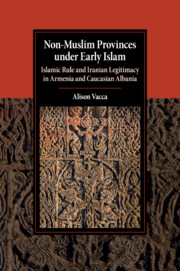 Non-Muslim Provinces under Early Islam
Non-Muslim Provinces under Early Islam Book contents
- Frontmatter
- Dedication
- Contents
- List of Illustrations
- Acknowledgments
- Situating Places, People, and Dates
- 1 Non-Persian Provinces of Iran, Non-Muslim Provinces of Islam: An Introduction to the Umayyad and ʿAbbāsid North
- 2 Whence the Umayyad North?: Byzantine, Sasanian, and Caliphal Administrative Geography of the North
- 3 Lost Greek Kings and Hoodwinked Khazars: Sasanian and Byzantine Legacy in the Construction of Caliphal Frontiers in the North
- 4 The So-Called Marzb ā ns and the Northern Freemen: Local Leadership in the North from Sasanian to Caliphal Rule
- 5 Caliphs, Commanders, and Catholicoi: Mechanisms to Control the North under Byzantine, Sasanian, and Caliphal Rule
- 6 Taxing the Dead and Sealing the Necks of the Living: Sasanian and Caliphal Treaties and Taxation in the North
- 7 Collective Historical Amnesia: The Case for a Parthian Intermezzo
- Bibliography
- Index
- Miscellaneous Endmatter
5 - Caliphs, Commanders, and Catholicoi: Mechanisms to Control the North under Byzantine, Sasanian, and Caliphal Rule
Published online by Cambridge University Press: 08 September 2017
- Frontmatter
- Dedication
- Contents
- List of Illustrations
- Acknowledgments
- Situating Places, People, and Dates
- 1 Non-Persian Provinces of Iran, Non-Muslim Provinces of Islam: An Introduction to the Umayyad and ʿAbbāsid North
- 2 Whence the Umayyad North?: Byzantine, Sasanian, and Caliphal Administrative Geography of the North
- 3 Lost Greek Kings and Hoodwinked Khazars: Sasanian and Byzantine Legacy in the Construction of Caliphal Frontiers in the North
- 4 The So-Called Marzb ā ns and the Northern Freemen: Local Leadership in the North from Sasanian to Caliphal Rule
- 5 Caliphs, Commanders, and Catholicoi: Mechanisms to Control the North under Byzantine, Sasanian, and Caliphal Rule
- 6 Taxing the Dead and Sealing the Necks of the Living: Sasanian and Caliphal Treaties and Taxation in the North
- 7 Collective Historical Amnesia: The Case for a Parthian Intermezzo
- Bibliography
- Index
- Miscellaneous Endmatter
Summary
Given the Iranian character of the traditions about the North and the large measure of independence allowed to the Northern élite, it might seem easy to dismiss summarily the idea of an “Umayyad” or an “ʿAbbāsid” North by arguing that caliphal rule was not consistently tied to a specific dynasty. On the one hand, the Caliphate went through periods of decentralization that, compounded with the deeply rooted system of hierarchical power in the North, meant that there were certainly moments when Armenia and Albania had at best a tenuous tie to Damascus or Baghdad. That said, there is concurrently considerable evidence to suggest that both the Umayyad and the ʿAbbāsid caliphs expected to exert direct control over the provinces, especially given the provinces’ status as frontiers. Thus the “Umayyad” quality of the Umayyad North is easily demonstrated with the elevation of Maslama b. ʿAbd al-Malik, Muḥammad b. Marwān, and Marwān b. Muḥammad as governors of the North. These governors were not only renowned warriors, but also sons of Umayyad caliphs. The ʿAbbāsids followed suit, as future caliphs such as Abū Jaʿfar Manṣūr and Hārūn al-Rashīd served as governors of the North before coming to power.
The goal of this chapter is to examine what we mean by caliphal “rule” in the decentralized North. In particular, it considers whether there are direct ties between how the Sasanian shāhanshāhs and the Umayyad and ʿAbbāsid caliphs engaged with and exerted control over the local populations across three main strata: the masses, the political élite, and the religious élite. A. Ter-Łevondyan, whose many works remain even today the most reliable studies of Arab–Armenian relations under the ʿAbbāsid Caliphate, notes that
The period of Arab domination in Armenia was characterized by certain traits which distinguish it from the previous Perso-Byzantine era. The natural policy of both the Sasanians and Byzantium toward Armenia was the attempt to bind the country to themselves by various religious and other ties. There was no thought in this period of colonizing Armenia with foreign elements, be they Persian or Greek… The Arab empire of the Caliphate developed and was organized in a different manner from that of Byzantium or the Sasanians.
- Type
- Chapter
- Information
- Non-Muslim Provinces under Early IslamIslamic Rule and Iranian Legitimacy in Armenia and Caucasian Albania, pp. 151 - 179Publisher: Cambridge University PressPrint publication year: 2017


